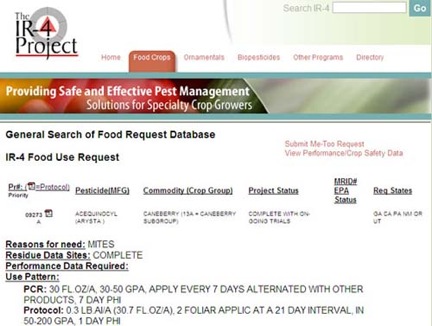 |
June 2009
|
June 2009 // Volume 47 // Number 3 // Ideas at Work // v47-3iw2
Priority Setting Tool for The Western Region IR-4 Center
Abstract
The IR-4 Project must select a limited number of pesticide registration projects each year from among many potential projects. This complex, national decision-making process is facilitated with the Priority Setting Tool (PST). The PST collects input from Extension and industry stakeholders and displays relevant projects with the result of improved project selection supporting Western specialty crop growers. This innovative process and tool could be adapted to any Extension program that has specific project goals that are prioritized by stakeholder input.
Background
The IR-4 Project is the largest petitioner to the US Environmental Protection Agency (EPA) for the registration of specialty crop pesticides. Over 40 years, the program has logged more than 10,00 requests from Extension personnel and specialty crop growers for pesticide uses on crops as diverse as avocados, bananas, carrots, and zucchini. Tools similar to those described here can be applied in Extension programs where limited resources heighten the need for reaching consensus among a broad range of competing interests.
Each year, resource limitations dictate that the IR-4 Program initiates only 50 to 70 projects nationally. The IR-4 Program consists of four geographic regions (Northeast, Southern, North Central, and Western) whose growers vie for the prioritization of their specific projects.
The IR-4 project selection process must balance:
- Regulatory requirements
- Regional needs
- Multiple requests
- Budget limitations
- Scientific merit of projects
The Western Region IR-4 covers 13 states west of the Rockies, including Hawaii and Alaska and the territory of Guam. Tracking and prioritizing the diverse needs of the Western states specialty crops prompted the Priority Setting Tool's (PST) development by the Western Region IR-4 Center, located at the University of California, Davis.
The primary purpose of the tool is to organize the plethora of projects well before the national Food Use Workshop. This workshop brings together several hundred growers and specialists from across the nation to determine exactly which projects IR-4 will initiate for the upcoming growing season. The competing needs and numerous projects have historically made this process quite challenging for all involved. The desire for concise, well organized information to support Western stakeholders was the driving need behind the development of the PST. The innovative process and tool described here could be adapted to any number of Extension programs where stakeholder input plays a key role in program direction.
The Priority Setting Tool
The PST, initially developed in 2004, integrates information from the national IR-4 database with data and input from Western region stakeholders. The Western Region input comes directly from growers, commodity representatives, researchers and University Extension personnel. Stakeholder input includes details of the project's importance to the Western region, efficacy data and any relevant hurdles that might hinder project completion.
The national IR-4 project maintains a database (Figure 1) that uniquely identifies all IR-4 requests by commodity and chemical. The database also tracks the project's priority rating (A, B, C, etc.) current status, and progress to date.
Figure 1.
Example of National IR-4 Online Database
Throughout a given year, two Western region teleconferences are held with stakeholders to obtain PST database input. In addition, there are many personal communications and e-mail exchanges that provide further input. These results are publically available on the Western Region IR-4 Web site (Figures 2 and 3) and updated throughout the season. The PST combines online technology with old-fashioned, one-on-one follow-up to streamline and increase the transparency of a key public decision-making process.
Final updates are made to the PST just prior to the national Food Use Workshop. All "A" priority projects from the national workshop will be initiated in the coming season. "B" projects can be started as resources permit. "C" and lower priority projects will not be started.
Figure 2.
The PST Web Site Showing Report
Options
Figure 3.
PST Report Showing Integrated
National and Regional Project Data
Outcomes and Impacts
The Western Region comes to the national Food Use Workshop with a succinct list of relevant projects. This project list is backed by Western Region stakeholders along with supporting data.
This collaborative effort to coordinate project information from the West helps the Western Region to advocate for and support regional needs on an ongoing basis. The tool represents a collective memory of projects and details used for current and future priority discussions.
The PST captures and synthesizes multiple regional project requests and the attendant information into a manageable package. This tool enables the Western Region to come to the national workshop discussion clearly understanding the relative merits of our projects. This effort has enhanced our ability to participate at the national level and meet the needs of Western growers.
References
IR-4 Project, Food use database search for project 9273. Retrieved June 5, 2008 from: http://ir4.rutgers.edu/FoodUse/food_Use2.cfm?Prnum=09273&CFID=66458&CFTOKEN=33443066
IR-4 Project. Western Region IR-4 priority setting tool (PST). Retrieved June 5, 2008 from: http://wrir4.ucdavis.edu/pst/
IR-4 Project, Western Region IR-4 priority setting tool (PST). Western Region priority project report. Retrieved June 5, 2008 from: http://wrir4.ucdavis.edu/pst/pst-wr.html




